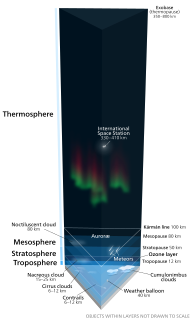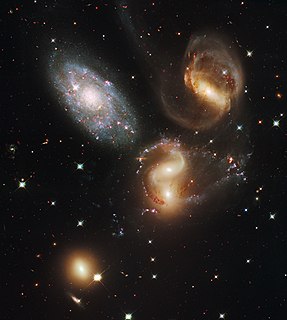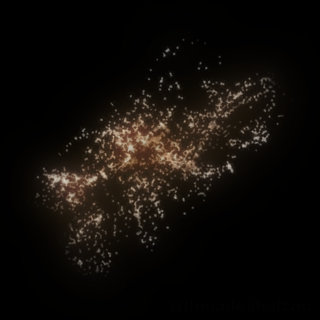Related Research Articles

Atomic absorption spectroscopy (AAS) and atomic emission spectroscopy (AES) is a spectroanalytical procedure for the quantitative determination of chemical elements using the absorption of optical radiation (light) by free atoms in the gaseous state. Atomic absorption spectroscopy is based on absorption of light by free metallic ions.

In physics, radiation is the emission or transmission of energy in the form of waves or particles through space or through a material medium. This includes:

X-ray astronomy is an observational branch of astronomy which deals with the study of X-ray observation and detection from astronomical objects. X-radiation is absorbed by the Earth's atmosphere, so instruments to detect X-rays must be taken to high altitude by balloons, sounding rockets, and satellites. X-ray astronomy uses a type of space telescope that can see x-ray radiation which standard optical telescopes, such as the Mauna Kea Observatories, cannot.

In astronomy, the interstellar medium (ISM) is the matter and radiation that exist in the space between the star systems in a galaxy. This matter includes gas in ionic, atomic, and molecular form, as well as dust and cosmic rays. It fills interstellar space and blends smoothly into the surrounding intergalactic space. The energy that occupies the same volume, in the form of electromagnetic radiation, is the interstellar radiation field.

Outer space is the expanse that exists beyond Earth and between celestial bodies. Outer space is not completely empty—it is a hard vacuum containing a low density of particles, predominantly a plasma of hydrogen and helium, as well as electromagnetic radiation, magnetic fields, neutrinos, dust, and cosmic rays. The baseline temperature of outer space, as set by the background radiation from the Big Bang, is 2.7 kelvins. The plasma between galaxies is thought to account for about half of the baryonic (ordinary) matter in the universe, having a number density of less than one hydrogen atom per cubic metre and a temperature of millions of kelvins. Local concentrations of matter have condensed into stars and galaxies. Studies indicate that 90% of the mass in most galaxies is in an unknown form, called dark matter, which interacts with other matter through gravitational but not electromagnetic forces. Observations suggest that the majority of the mass-energy in the observable universe is dark energy, a type of vacuum energy that is poorly understood. Intergalactic space takes up most of the volume of the universe, but even galaxies and star systems consist almost entirely of empty space.
Quantum foam is the quantum fluctuation of spacetime on very small scales due to quantum mechanics. Matter and antimatter is constantly created and destroyed. These subatomic objects are called virtual particles. The idea was devised by John Wheeler in 1955.

Absorption spectroscopy refers to spectroscopic techniques that measure the absorption of radiation, as a function of frequency or wavelength, due to its interaction with a sample. The sample absorbs energy, i.e., photons, from the radiating field. The intensity of the absorption varies as a function of frequency, and this variation is the absorption spectrum. Absorption spectroscopy is performed across the electromagnetic spectrum.

Stephan's Quintet is a visual grouping of five galaxies of which four form the first compact galaxy group ever discovered. The group, visible in the constellation Pegasus, was discovered by Édouard Stephan in 1877 at the Marseille Observatory. The group is the most studied of all the compact galaxy groups. The brightest member of the visual grouping is NGC 7320, which has extensive H II regions, identified as red blobs, where active star formation is occurring.
The terms galactic corona and gaseous corona have been used in the first decade of the 21st century to describe a hot, ionised, gaseous component in the galactic halo of the Milky Way. A similar body of very hot and tenuous gas in the halo of any spiral galaxy may also be described by these terms.

Extended X-Ray Absorption Fine Structure (EXAFS), along with X-ray Absorption Near Edge Structure (XANES), is a subset of X-ray Absorption Spectroscopy (XAS). Like other absorption spectroscopies, XAS techniques follow Beer's law. The X-ray absorption coefficient of a material as a function of energy is obtained using X-rays of a narrow energy resolution are directed at a sample and the incident and transmitted x-ray intensity is recorded as the incident x-ray energy is incremented.
The Constellation-X Observatory was a mission concept for an X-ray space observatory to be operated by NASA; in 2008 it was merged with ESA and JAXA efforts in the same direction to produce the International X-ray Observatory project, announced on 24 July 2008.

Claude R. Canizares is an American physicist who stepped down June 30, 2015 from his post as Vice President of MIT. He remains the Bruno Rossi Professor of Physics at MIT and associate director for MIT of the Chandra X-Ray Observatory Center.

The Cosmic Origins Spectrograph (COS) is a science instrument that was installed on the Hubble Space Telescope during Servicing Mission 4 (STS-125) in May 2009. It is designed for ultraviolet (90–320 nm) spectroscopy of faint point sources with a resolving power of ≈1,550–24,000. Science goals include the study of the origins of large scale structure in the universe, the formation and evolution of galaxies, and the origin of stellar and planetary systems and the cold interstellar medium. COS was developed and built by the Center for Astrophysics and Space Astronomy (CASA-ARL) at the University of Colorado at Boulder and the Ball Aerospace and Technologies Corporation in Boulder, Colorado.
Anomalous X-ray scattering is a non-destructive determination technique within X-ray diffraction that makes use of the anomalous dispersion that occurs when a wavelength is selected that is in the vicinity of an absorption edge of one of the constituent elements of the sample. It is used in materials research to study nanometer sized differences in structure.
Surface-extended X-ray absorption fine structure (SEXAFS) is the surface-sensitive equivalent of the EXAFS technique. This technique involves the illumination of the sample by high-intensity X-ray beams from a synchrotron and monitoring their photoabsorption by detecting in the intensity of Auger electrons as a function of the incident photon energy. Surface sensitivity is achieved by the interpretation of data depending on the intensity of the Auger electrons instead of looking at the relative absorption of the X-rays as in the parent method, EXAFS.

The warm–hot intergalactic medium (WHIM) is the sparse, warm-to-hot (105 to 107 K) plasma that cosmologists believe to exist in the spaces between galaxies and to contain 40–50% of the baryonic 'normal matter' in the universe at the current epoch. The WHIM can be described as a web of hot, diffuse gas stretching between galaxies, and consists of plasma, as well as atoms and molecules, in contrast to dark matter. The WHIM is a proposed solution to the missing baryon problem, where the observed amount of baryonic matter does not match theoretical predictions from cosmology.
The Cloverleaf quasar is a bright, gravitationally lensed quasar.
Advanced Telescope for High-ENergy Astrophysics (Athena) is an X-ray observatory mission selected by European Space Agency (ESA) within its Cosmic Vision program to address the Hot and Energetic Universe scientific theme. Athena will operate in the energy range of 0.2–12 keV and will offer spectroscopic and imaging capabilities exceeding those of currently operating X-ray astronomy satellites – e.g. the Chandra X-ray Observatory and XMM-Newton – by at least one order of magnitude on several parameter spaces simultaneously.

The Sculptor Wall is a superstructure of galaxies relatively near to the Milky Way Galaxy, also known as the Sculptor superclusters.
The missing baryon problem arises from a mismatch between the amount of baryonic matter detected shortly after the Big Bang and at late times. Over the last decades, observations of the cosmic microwave background and Big Bang nucleosynthesis studies have set strict constraints on the abundance of baryons in the early universe, finding that baryonic matter accounts for 4.85% of the energy contents of the Universe. At the same time, census of baryons in the late Universe have found that all the mass in planets, stars, interstellar gas, and gas surrounding galaxies only accounts for less than half of the baryons detected in the early Universe. This strong discrepancy is commonly known as the missing baryon problem. The missing baryon problem is distinct from the dark matter problem, which is non-baryonic in nature.
References
- 1 2 "H2356-309: X-ray Discovery Points to Location of Missing Matter". Chandra. Retrieved 28 November 2019.
- 1 2 3 "QSO B2356-309". Simbad. Retrieved 27 November 2019.
- ↑ Fang, Taotao (2010). "Confirmation of X-Ray Absorption by Warm-Hot Intergalactic Medium in the Sculptor Wall". The Astrophysical Journal. 714 (2): 1715–1724. arXiv: 1001.3692 . Bibcode:2010ApJ...714.1715F. doi:10.1088/0004-637X/714/2/1715. S2CID 17524108.